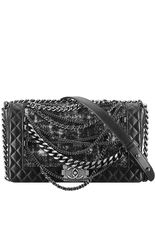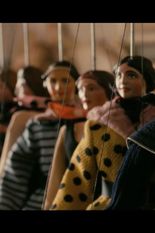How costume design got into our wardrobes
It is hardly surprising that Caroline McCall, the costume designer of Downton Abbey, has given 'absolutely no thought' to what she will wear to the Primetime Emmy Awards Ceremony on 22 September. Nominated in the category of Outstanding Costumes for a Series, McCall's shot at the prestigious television industry laurel recognises the colossal task she has accomplished of maintaining the standard of sartorial excellence for which Downton has been renowned since the award-winning period drama first aired on ITV on 26 September 2010.
Fashion titans Ralph Lauren and Alberta Ferretti are merely a couple of the designers who have looked to the show for inspiration. But McCall claims she has hardly noticed the impact of her painstaking handiwork. She has toiled on Downton since the first series, originally as the assistant in Susannah Buxton's wardrobe department. After Buxton - the original Downton costumer – quit the series to pursue other projects in 2012, McCall took over the reigns and has never looked back.
She has just completed nine months of shooting series four across the country, from Newbury's majestic Highclere Castle to Mayfair, London, ensuring that the show's wardrobe of period finery – most of which is made from scratch – appears beautifully on Downton's ensemble cast. There are 'so many clothes' required for its eight episodes as well as the lavish annual Christmas special, says McCall, that it is impossible for her to calculate an exact number of garments she assembles each season, or contemplate much else other than her work, once the cameras roll.
For one storyline, which featured over two episodes in season three, for example, McCall conceived 43 evening dresses. Prompted by her work, 'people that I never imagined have been in touch', she admits, alluding to exciting professional opportunities that have recently come her way. A Downton jewellery line is soon to drop at the American department store Macy's and will also be available on Amazon. Though a high-street clothing line has long been rumoured to be in the works, McCall refuses to confirm its making, although the time seems particularly right for adaptations of the sartorial splendour she conceives. Not since the Golden Age of Hollywood – or the more recent heyday of Patricia Field, who revived fashion on TV with Sex and the City – has the work of top costumers like McCall proved so influential. Or in demand.
Soon to debut at American department stores, for example, is a Revenge clothing line of dresses based on the striking numbers that costume designer Jil Ohanneson has sourced for the ABC television drama set amidst the group of exclusive villages of Long Island, New York, known as the Hamptons. Lyn Paolo, the British costumer who has made an impact with the minimalist wardrobe she has crafted for Kerry Washington's Olivia Pope on Scandal – which incorporates Tory Burch and Giorgio Armani – is currently 'trying to figure out' how to launch a retail clothing line inspired by the American political thriller. Costume designer Daniel Lawson is also investigating retail opportunities to make accessible the slick yet feminine 'Chicago Chic' he conceives for The Good Wife, although the development process for a retail line can be complex and protracted.
Unlike launching a collection, which is the brainchild of one designer, a television retail fashion collaboration is a group effort that must be approved by a production's principal members. 'There are so many people involved – actors, producers,' says Debra McGuire. The Los Angeles costume designer conceived the wardrobes for Friends and New Girl and has also received a 2013 Emmy nomination for her work on the riveting HBO TV film Phil Spector. 'It can only happen when all the parties are on board.'
Prominent costume designers, however, also now enjoy the perks once strictly enjoyed by A-list fashion stylists – such as consulting and serving as ambassadors for major brands, as well as launching their own namesake labels. Two designers favoured by Michelle Obama – Barbara Tfank and L'Wren Scott – launched their eponymous womenswear lines in 2001 and 2006, respectively, after working as Hollywood costume designers in the 90s. Michael Kaplan, the blockbuster film costume designer, known for his work on Bladerunner, Fight Club, Mr. and Mrs. Smith and Mission Impossible, produced a line of Swarovski jewellery last year. Soyon An, the Emmy-winning costume consultant for American Idol and So You Think You Can Dance, consulted for Forever 21 while Jenn Roigen, the costume designer of Girls, was recently appointed a style expert for American Eagle's lingerie brand Aerie.
Back in March, Janie Bryant launched the third Banana Republic collection inspired by the retro cool wardrobe she has created for Mad Men. Along with her work as a spokesperson for mass-market brands such as Maidenform lingerie and Downy fabric softener, Bryant has also conceived a leather goods collection for QVC. Next up is Janie Bryant's Hollywood. According to Women's Wear Daily, this competition reality show will investigate Bryant's passions for film, costume and fashion design and also feature a retail tie-in so that the designs that appear on air can be purchased by the audience tuning in. 'For the past few years we have really been seeing how fashion is influenced by film and TV,' Bryant has explained. 'People want to know and buy what characters are wearing.'
The impulse has preoccupied women for over a century. Early Hollywood silent screen stars lent their names to cosmetics and skincare. Seven thousand contestants entered a 1929 competition to win the pretty tulle 'Orchid Dress' by Los Angeles designer Howard Greer that Mary Pickford flaunted in her first sound film, Coquette. Pickford staged the contest as part of her campaign to win the second Best Actress Academy Award and before she clinched the prize for the romantic drama she was photographed bestowing her film costume to the supermarket clerk who won the contest.
By the 1930s, legendary Golden Era Hollywood costume designers – such as MGM's Gilbert Adrian and Paramount's Travis Banton – mastered the fine art of creating film wardrobes that not only interpreted a script but also captured the directional sophistication of high fashion. 'Many, many more thousands of women went to the movies than studied high fashion magazines,' noted fashion historian Caroline Rennolds Milbank, and so MGM produced an affordable retail collection based on the bold styles Adrian created for Joan Crawford.
Retail collaborations were never Travis Banton's thing. A New York-trained fashion designer, Banton was the closest thing in Hollywood to a couturier. He cut costumes from couture textiles including tweeds from Linton, the Scottish Borders knitwear manufacturer that Coco Chanel used, sourced beads from Lesage in Paris and enlisted his former assistant, New York milliner Lily Daché to conceive hats for Paramount's leading ladies. Ultimately, Banton is revered for creating outlandish costumes that Marlene Dietrich flaunted in six Paramount films directed by Josef Von Sternberg. 'Day in, day out they worked sometimes for 12 hour stretches,' wrote Maria Riva, Dietrich’s daughter, recalling her fittings. Banton's assistant Edith Head, recalled them working through a 36-hour session, simply to select a single hat for a film scene. 'We sat up for hours trying on dozens of different hats,' recalled Head, 'changing them, tilting them, taking off this one and trying that one, snipping off a veil or a brim.'
Head proved the forerunner of today's dynamic, multitasking costume designers. As Hollywood's uncontested style leader in the 1950s, she delegated the design work at Paramount to her staff of 50 and pursued innumerable ventures. Though her appearances on daytime American TV as a celebrity fashion expert and her work authoring lifestyle books elevated her profile, Head's projects also significantly elevated the status of the costume design profession. She made house calls to the celebrities she dressed for the screen to organise their personal wardrobes. The Oscar gowns Head crafted for a legion of Paramount stars including Grace Kelly, Janet Leigh, Sofia Loren and Shirley MacLaine remain renowned for their beauty and continue to be referenced. Head was also the first fashion consultant for the Academy Awards, a post which she fulfilled for 16 years from 1953 to ensure that nominees and presenters looked their best on the televised awards show. The total of eight Academy Awards, which Head received for All About Eve and Roman Holiday among other classics, still remains unrivalled.
Though she pursued innumerable sidelines, Head was utterly dedicated to her craft and gave her all to the directors and producers with whom she worked. She also mothered the film stars she styled such as Elizabeth Taylor, who was a frequent houseguest at Casa Ledera - Head's Spanish colonial Beverly Hills home (which is now owned by Carrie Fisher). Grace Kelly always ate lunch in 'Edie's Room' as Head's office on the Paramount studio lot was known. When Alfred Hitchcock insisted that Kelly appear as the epitome of chic as heiress Frances Stevens in To Catch a Thief, Head pulled out all the stops, organising the actresses's first shopping trip to Hermès in Paris. And there, together, Head and Kelly sourced accessories for the Frances Stevens character. Two years after Thief's release, Kelly appeared in Life magazine toting a boxy Hermès handbag known as 'Sac à dépêche' which was soon renamed as the Kelly bag.
Bob Mackie did time on Edith Head's team at Paramount and, by the Seventies, had transferred the Old Hollywood cinematic tradition of unfettered sartorial luxury and bespoke craftsmanship to his work masterminding the costumes on weekly television shows, including The Sonny and Cher Comedy Hour and The Carol Burnett Show – albeit with a comic spin. 'Bob’s sketches were extraordinary and his workmanship was couture quality,' remembers Michael Kaplan, who worked as Mackie's assistant in the early Seventies.
By then, Hollywood studios had been sold to corporations and, as their wardrobe departments were shut down, costume design for film and television fell to a freelance workforce that remains independent. Sourcing previously worn pieces from costume workshops, shopping for inexpensive fashion and accessories, which look as good as luxury items on screen, and bartering with brands – exchanging a film credit for designer handiwork – became common practices that continue today.
Louis Vuitton, for example, bestowed a set of luggage to Blue Jasmine so that its star Cate Blanchett could tote authentic pieces portraying the title character in the Woody Allen drama. Debra McGuire's budget on Phil Spector, however, precluded the purchase of an authentic Hermès Birkin for Helen Mirren to wield as the music mogul's defense attorney Linda Kenney Baden. So McGuire sourced a good fake and carefully aged the handbag so on screen it looked as good as the real thing. As for what McGuire will wear to the upcoming Emmys, she does admit that she has given it some thought, unlike Downton Abbey's McCall. 'One year, I made a silver crochet dress for the ceremony,' explains McGuire. 'I got out of the limousine and thought "Who am I kidding? I'm not the movie star." So right now, I have an All Saints gown and a trouser suit. Whatever I wear, this year, it will be understated.'



















